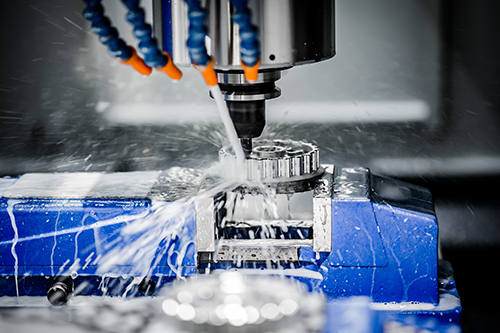
Metalworking fluids (MWFs) are essential in machining and metal-forming processes, providing lubrication, cooling, and corrosion protection. A well-formulated metalworking fluid enhances tool life, improves surface finish, increases production rates, and maintains workplace safety. This article outlines the key components and formulation process for a basic metalworking fluid.
- Understanding Metalworking Fluid Types
Metalworking fluids are categorized into four main types:
- Straight Oils – Pure oils without water, used for heavy-duty machining.
- Soluble Oils – Oil-based fluids that emulsify in water, offering lubrication and cooling.
- Synthetic Fluids – Water-based solutions with no oil content, providing superior cooling.
- Semi-Synthetic Fluids – A blend of soluble oil and synthetic elements for balanced performance.
For this article, we will focus on formulating a basic soluble oil metalworking fluid, as it is widely used in general machining applications.
- Key Ingredients of a Basic Soluble Oil Fluid
A well-balanced formulation requires a combination of components, each serving a specific function:
- Base Oil (50-70%): The primary lubricant, typically a mineral or vegetable oil. These oils can be Naphthenic or Paraffinic in nature. For synthetic formulations, Polyalkylene Glycols (PAGs) or specialty esters can be used.
- Emulsifiers (5-15%): Surfactants that help disperse oil in water, such as nonionic or anionic emulsifiers, fatty acid soaps, sulfonates, or alkanolamides. Glycols such as DEG or DPG can be use as co-emulsifiers.
- Corrosion Inhibitors (2-5%): Additives like sodium sulfonates or amine-based compounds to prevent rust formation. Blends of dibasic acids, such as Sebacic Acid, Dodecanedioic Acid (DDDA), or Undecanedioic Acid (UDDA) are commonly used. Tolyltriazole and Benzotriazole can be used for copper corrosion protection.
- Extreme Pressure (EP) Additives (1-5%): Sulfides, chlorinated paraffins, or phosphate ester compounds are added to reduce friction and wear.
- Biocides (0.1-1%): Antimicrobial agents to prevent bacterial and fungal growth, extending fluid life. Examples of biocides include Triazine, Oxazolidine, Isothiazoline, and phenolics. Fungicides include products such as Sodium Pyrithione.
- Anti-Foaming Agents (0.1-1%): Silicone-based, fumed silica, quaternary ammonium salts, or polymer additives to minimize foaming.
- Water (Variable, typically 30-50%): The carrier fluid that provides cooling and dilution.
- Formulating a Basic Soluble Oil Metalworking Fluid
Step 1: Choosing the Base Oil
Select a high-quality mineral oil with good oxidation stability and low viscosity for easy emulsification. For the most part, Naphthenic base oils dominate the U.S. MWF market, although paraffinic oils can be used as well. Vegetable oils can be used for eco-friendly formulations, but also pose challenges with stability. Specialty esters can provide hydrolytic stability and offer better lubrication properties than traditional mineral oils.
Step 2: Adding Emulsifiers
Blend in nonionic and anionic emulsifiers to ensure the oil disperses well in water. Common choices include fatty acid esters and sulfonates.
Step 3: Incorporating Corrosion Inhibitors
Add sodium sulfonates or alkanolamines to prevent rust formation on metal surfaces. Ensure compatibility with other additives.
Step 4: Enhancing Lubrication with EP Additives
Introduce sulfurized, chlorinated, or phosphorus-based compounds for extreme pressure protection, particularly for high-friction operations like threading and tapping.
Step 5: Preventing Microbial Growth
Include a biocide such as formaldehyde-releasing compounds or boron-based preservatives to inhibit bacterial contamination.
Step 6: Controlling Foam Formation
Incorporate a small amount of an anti-foaming agent, such as polysiloxane, to prevent excessive foaming during operation.
Step 7: Dilution with Water
Slowly mix the concentrate with water (typically at a 5-10% concentration) to create a stable emulsion. Always add oil to water, not the other way around, to ensure proper emulsification.
- Testing and Performance Evaluation
Once formulated, the metalworking fluid should be tested for:
- Emulsion Stability – Ensure no phase separation occurs.
- Lubricity – Evaluate friction reduction under load.
- Corrosion Resistance – Test metal parts for rust prevention.
- Foaming Characteristics – Check for excessive foam during use.
- Microbial Resistance – Monitor bacterial growth over time.
- Maintenance and Fluid Management
Metalworking fluids are carefully formulated with performance features specific to each job. Because they are inherently open to environmental and use stress, they can lose the proper balance over time, which can lead to performance problems or hazardous working conditions for operators. To maximize the performance and longevity of the metalworking fluid:
- Regularly monitor concentration with a refractometer.
- Maintain proper pH levels (typically 8.5-9.5) to prevent corrosion.
- Implement a filtration system to remove contaminants.
- Periodically replace the fluid to prevent degradation.
Conclusion
A well-formulated metalworking fluid is essential for efficient machining and extended tool life. By carefully selecting the right base oil, emulsifiers, corrosion inhibitors, and additives, you can create a high-performing fluid suitable for various metalworking operations. Regular monitoring and maintenance ensure optimal performance and workplace safety.
